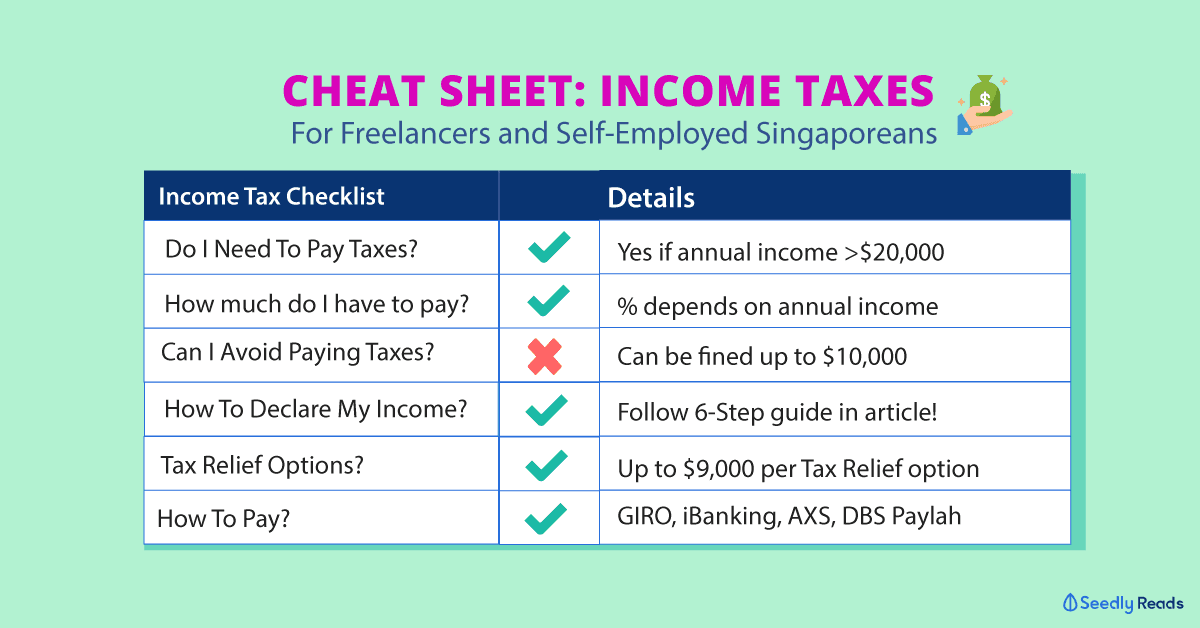Self-employed persons made up 8 to 10 per cent of the resident workforce in Singapore.
With graduates finding it increasingly hard to find a job in Singapore, many turn to short-term contract roles and freelance jobs to help sustain their lifestyles.

While some may view freelance work as a hobby, there are others who decide to settle into it for the long haul.
If you fall into any of the jobs below, this one’s for you!
- Tutors
- Insurance Agents
- Property Agents
- Private Hire Drivers
- Photographers or Videographers
- Social Media Influencers
- Designers
(This list is not exhaustive)
TL;DR: Here’s All You Need To Know About Your Income Taxes As A Freelancer

Wah Shiok! Freelancers Don’t Need To Pay Taxes?!
Before you get too happy, this is not true. For those of you who didn’t know, you are required to pay income tax once your income exceeds $22,000 in a year!
This means that if you’re getting an average take-home pay of ~$1800/month, you will have to pay income taxes to IRAS.
If you’re not working but receive the following income (that exceeds $22,000/yr), you are also required to pay income taxes:
- Income from investments
- NSman income (including all awards and allowance such as IPPT monetary incentives)
- Part-time income
- Pension
- Royalty income
- Supplementary Retirement Scheme withdrawals
How Much Income Tax Do I Have To Pay?

Before delving into the details, you have to note that your income tax is tabulated based on your yearly employment income.
For Singapore Residents, your tax rates for 2019/2020 are as follows:
Singapore Income Tax Rates 2019/2020 for Residents
| Chargeable Income | Income Tax Rate (%) | Gross Tax Payable (S$) | Total Income Tax in this income bracket (S$) |
|---|---|---|---|
| First $20,000 Next $10,000 | 0 2 | 0 200 | 200 |
| First $30,000 Next $10,000 | - 3.50 | 200 350 | 550 |
| First $40,000 Next $40,000 | - 7 | 550 2,800 | 3,350 |
| First $80,000 Next $40,000 | - 11.50 | 3,350 4,600 | 7,950 |
| First $120,000 Next $40,000 | - 15 | 7,950 6,000 | 13,950 |
| First $160,000 Next $40,000 | - 18 | 13,950 7,200 | 21,150 |
| First $200,000 Next $40,000 | - 19 | 21,150 7,600 | 28,750 |
| First $240,000 Next $40,000 | - 19.50 | 28,750 7,800 | 36,550 |
| First $280,000 Next $40,000 | - 20 | 36,550 8,000 | 44,550 |
| First $320,000 In excess of $320,000 | - 22 | 44,550 | - |
*Note: Chargeable income refers to the income you earn in a year
You will be treated as a tax resident for a particular YA if you are:
- Singaporean citizen or Singapore Permanent Resident residing in Singapore;
- A foreigner who has stayed/worked in Singapore (excluding director of a company) for 183 days or more in the previous year.
(However, if you are the BiG B0$$- i.e director of a company, you will be taxed differently)
Too complicated? You can use this Personal tax Calculator to calculate the exact amount of taxes you have to pay!
“I don’t want to pay, can siam or not?”
Let’s get real, nobody really likes to pay taxes. For freelancers and self-employed individuals, there is always that temptation to not declare your income. That is however deemed as tax evasion, and you will get fined for it.
Not filing your tax return correctly could get you fined up to 300% of the amount of the taxes you were supposed to pay for. You can also be fined up to $10,000 and/or up-to 3 years of imprisonment.

How To Declare Your Income As A Self Employed Person?
Here’s the important part:
All self-employed persons must report the income earned from their business operations as business income, and not as salary. The business income is part of the total personal income which is taxed at individual income tax rates. Here’s a step-by-step guide on how to go about doing it:
| Step 1 | Report earnings as business income. | The business income is part of the total personal income which is taxed at individual income tax rates. |
| Step 2 | Decide on the accounting period | Every year, you declare your business income for a specific accounting period. The accounting period is usually a 12-month period of trade for which you calculate your profits or losses. E.g Accounting Period: 1 Jan 2018 to 31 Dec 2018 (YA 2019) |
| Step 3 | Keep Proper Records And Accounts | Keep full and accurate records and accounts of your business transactions from the start. These records and accounts must be supported with invoices, receipts, vouchers, and other documents. |
| Step 4 | Prepare Statement of Accounts | At the end of every accounting period, you must prepare the statement of accounts comprising: Profit and Loss Accounts Balance Sheet |
| Step 5 | Prepare 4-Line Statement | First line: Revenue Second line: Gross Profit Third Line: Allowable Business Expenses Fourth line: Adjusted Profit |
| Step 6 | File Income Tax | At the beginning of the year and usually by 15 Mar, IRAS will send you a notification or an individual income tax return (Form B or B1) to report your income. |
For more information, you can refer to the IRAS Website.
How Can I Reduce The Amount Of Income Taxes I Have To Pay?
Tax Reliefs
For those who’d want to reduce their taxable income (legally), here’s how you can do it without being sued for tax evasion:

Tax Reliefs Available For All Singapore’s Tax Residents
| General Reliefs Available to ALL Taxpayers | Amount of Tax Relief Each Year | Additional Reliefs Available to Married/ Divorced/ Widowed Taxpayers | |
|---|---|---|---|
| Note: Eligibility is dependent on individual meeting the qualifying criteria | Available to Male and Female Taxpayers | Available to Female Taxpayers | |
| Course Fees Relief | Up to $5,500 | Qualifying/ Handicapped Child Relief Spouse/ Handicapped Spouse Relief | Foreign Domestic Worker Levy Relief Grandparent Caregiver Relief Working Mother's Child Relief |
| CPF Cash Top Up for Special/Retirement/MediSave accounts (not allowed by CPF Board if the recipient is a self-employed person (SEP) with outstanding MediSave liabilities) (You and your family member) | Up to $16,000 ($8,000 for self, $8,000 for family members) |
||
| CPF Relief for Self-Employed | Tax relief for your compulsory Medisave and voluntary CPF contributions will be capped at the lowest of: -37% of your net trade income assessed for YA 2023 -CPF annual limit of $37,740 -Actual amount contributed by you in 2022 |
||
| Earned Income Relief | Below 55: $1,000 55 to 59: $6,000 60 and above: $8,000 |
||
| Earn Income Relief (for handicapped person) | Below 55: $4,000 55 to 59: $10,000 60 and above: $12,000 |
||
| Handicapped Brother/Sister Relief | $5,500 for each handicapped sibling or sibling-in-law | ||
| Foreign Domestic Worker Levy (FDWL) Relief | Normal: $7,200 or $10,800 Concessionary: $1,440 |
||
| Life Insurance Relief (Your total contributions for the following in 2022 was less than $5,000: a. compulsory employee’s CPF contribution b. compulsory Medisave/voluntary CPF contribution as a self-employed individual) | The lower of the: Difference between $5,000 and your CPF contribution OR Up to 7% of the insured value of your own/your wife's life or the amount of insurance premiums paid |
||
| NSman Relief | Self: $1,500 - $5,000 Wife: $750 Parent With NSman child: $750 |
||
| Parent Relief | Taxpayer stays with dependant: $9,000 per dependant Taxpayer does not stay with dependant: $5,500 per dependant |
||
| Handicapped Parent Relief | Taxpayer stays with dependant: $14,000 per dependant Taxpayer does not stay with dependant: $10,000 per dependant |
||
| Supplementary Retirement Scheme (SRS) Relief | Singapore Citizens/Permanent Residents: lower of actual contribution or $15,300 Foreigners: lower of actual contribution or $35,700 |
||
Want to know more? This Cheat Sheet For Personal Income Tax In Singapore (2020) will be useful for both freelancers and employed persons.
How Do I Pay My Income Tax?
- GIRO
Online Application (Instant) / GIRO Form (3 weeks processing time) - iBanking
- AXS / SAM station
- DBS PayLah!
If you are unable to pay your tax in one lump sum, IRAS allows you to stagger your income tax payable over a stretch of 12 months, with no interest.
This applies to everyone as well.
More ways available here.
The community had also shared with us what the best way is to make your income tax payment.
Income Tax For Freelancers
Whether it’s getting covered by insurance, contributing to your CPF, or filing for your income taxes.
There are a lot of things you’d have to figure out yourself if you are a freelancer or self-employed person.
As your own HR manager, you have to always be in the loop!
Advertisement

